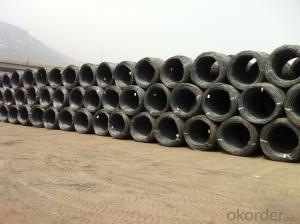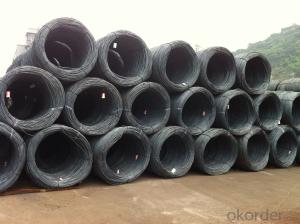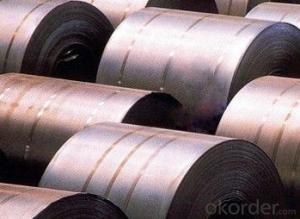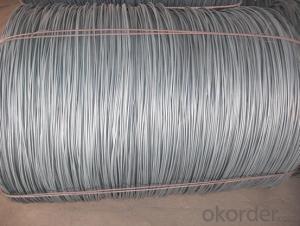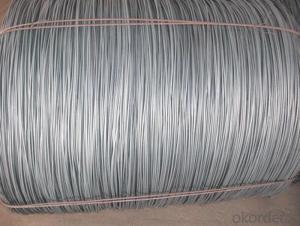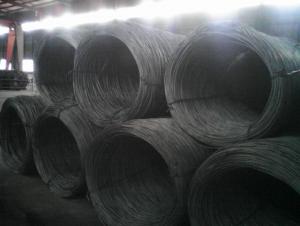SAE1008 Wire Rods with Competitive Price and Quality
- Loading Port:
- Tianjin
- Payment Terms:
- TT OR LC
- Min Order Qty:
- 25 m.t.
- Supply Capability:
- 20000 m.t./month
OKorder Service Pledge
OKorder Financial Service
You Might Also Like
Product Description:
OKorder is offering SAE1008 Wire Rods at great prices with worldwide shipping. Our supplier is a world-class manufacturer of steel, with our products utilized the world over. OKorder annually supplies products to European, North American and Asian markets. We provide quotations within 24 hours of receiving an inquiry and guarantee competitive prices.
Product Applications:
SAE1008 Wire Rods are ideal for structural applications and are widely used in the construction of buildings and the manufacturing, industries.
Product Advantages:
OKorder's Wire Rods are durable, strong, and resist corrosion.
Main Product Features:
· Premium quality
· Prompt delivery & seaworthy packing (30 days after receiving deposit)
· Corrosion resistance
· Can be recycled and reused
· Mill test certification
· Professional Service
· Competitive pricing
Product Specifications:
Manufacture: Hot rolled
Grade: SAE1006 – SAE1008
Certificates: ISO, SGS, BV, CIQ
Length: 6m – 12m, as per customer request
Packaging: Export packing, nude packing, bundled
Grade | Chemical Composition (%) | |||||
C | Mn | S | P | Si | B | |
SAE1006B | 0.03~O.07 | 0.32max | 0.045max | 0.040max | 0.30max | 0.0008min |
Mechanical properties | ||||||
Yield strength(N/mm2) | Tensile strength(N/mm2) | Elongation (%) | ||||
250-280 | 350-380 | ≥32 | ||||
Grade | Chemical Composition (%) | |||||
C | Mn | S | P | Si | B | |
SAE1008B | 0.10max | 0.3~0.50 | 0.050max | 0.040 max | 0.15max | 0.0008 min |
Mechanical properties | ||||||
Yield strength(N/mm2) | Tensile strength(N/mm2) | Elongation (%) | ||||
≥195 | 315-430 | ≥30 | ||||
FAQ:
Q1: Why buy Materials & Equipment from OKorder.com?
A1: All products offered byOKorder.com are carefully selected from China's most reliable manufacturing enterprises. Through its ISO certifications, OKorder.com adheres to the highest standards and a commitment to supply chain safety and customer satisfaction.
A2: Stainless does not "rust" as you think of regular steel rusting with a red oxide on the surface that flakes off. If you see red rust it is probably due to some iron particles that have contaminated the surface of the stainless steel and it is these iron particles that are rusting. Look at the source of the rusting and see if you can remove it from the surface.
Q3: What makes stainless steel stainless?
A3: Stainless steel must contain at least 10.5 % chromium. It is this element that reacts with the oxygen in the air to form a complex chrome-oxide surface layer that is invisible but strong enough to prevent further oxygen from "staining" (rusting) the surface. Higher levels of chromium and the addition of other alloying elements such as nickel and molybdenum enhance this surface layer and improve the corrosion resistance of the stainless material.
Images:
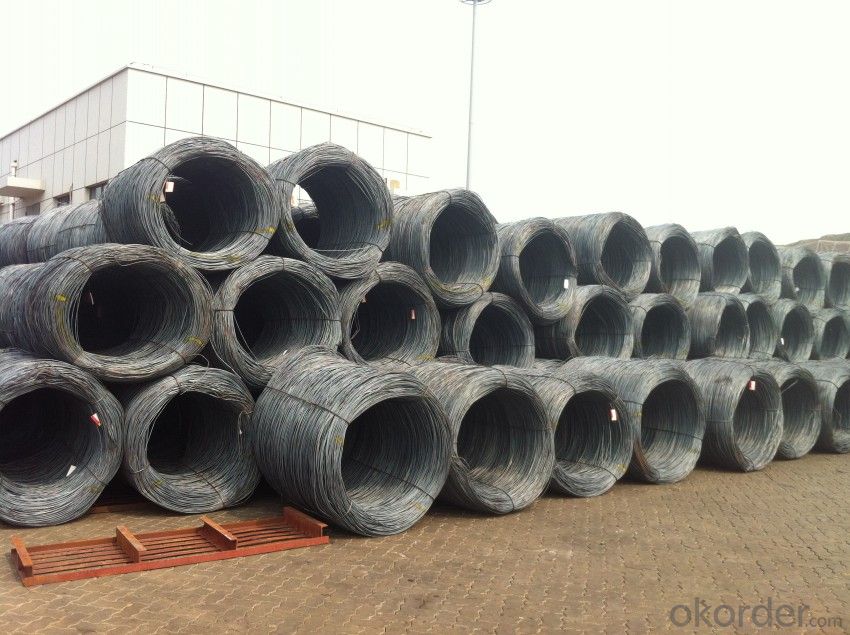
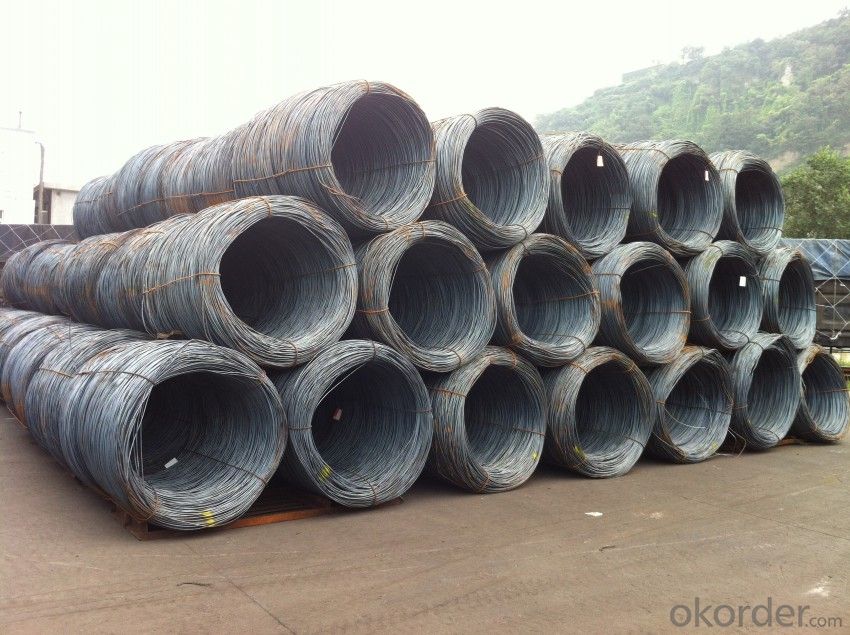
- Q:How is steel wire rod used in the manufacturing of wire forms for marine equipment?
- Steel wire rod is used in the manufacturing of wire forms for marine equipment because of its high strength and corrosion resistance properties. It is commonly shaped and formed into various wire products such as cables, ropes, and springs, which are essential components in marine equipment like ships, offshore platforms, and fishing vessels. The steel wire rod provides the necessary strength and durability needed to withstand harsh marine environments and heavy loads, ensuring the safety and reliability of the equipment.
- Q:What are the common production processes for lead-coated steel wire rod?
- The common production processes for lead-coated steel wire rod typically involve steps such as wire rod cleaning, lead coating application, drying, and coiling. The wire rod is first cleaned to remove any impurities or contaminants. Then, a lead coating is applied to the wire rod using methods like hot-dipping or electroplating. After the coating is applied, the wire rod is dried to ensure it is fully cured and ready for use. Finally, the coated wire rod is coiled for storage or further processing.
- Q:What are the standard fatigue resistance requirements for steel wire rod?
- The standard fatigue resistance requirements for steel wire rod vary depending on the specific application and industry standards. However, common fatigue resistance requirements for steel wire rod include meeting certain endurance limits, fatigue strength, and fatigue life expectations specified by the relevant standards organization or customer specifications. Additionally, factors such as the wire rod's diameter, surface condition, and chemical composition can also impact its fatigue resistance.
- Q:How is a steel wire rod manufactured?
- A steel wire rod is manufactured through a series of steps in a steel mill. The process begins with the melting of iron ore in a blast furnace to remove impurities and create molten iron. The molten iron is then transferred to a basic oxygen furnace (BOF) or an electric arc furnace (EAF) for further refining. In the BOF or EAF, the molten iron is combined with scrap steel and other alloying elements to achieve the desired composition and quality. This mixture is then subjected to high temperatures and chemical reactions, which help remove impurities and adjust the carbon content. Once the desired composition is achieved, the molten steel is cast into billets or blooms through continuous casting. These billets or blooms are solidified into a semi-finished product, which is then reheated to a rolling temperature. The reheated billet or bloom is then passed through a series of rolling mills. In the first stage, it goes through a roughing mill that reduces its size and shape. From there, it enters a series of intermediate and finishing mills, which gradually reduce the cross-sectional area and refine the shape further. During the rolling process, the steel is subjected to high pressure, which elongates it and reduces its diameter. This continuous elongation and reduction in size help improve the strength and ductility of the wire rod. After the final rolling pass, the wire rod is cooled and coiled onto a spool. It is then subjected to various surface treatments, such as pickling or coating, to remove any mill scale or oxidation and improve its surface quality. Finally, the wire rod is tested for its mechanical properties, dimensions, and surface quality. It is then either shipped to customers as a finished product or further processed into various steel wire products, such as wires for construction, automotive, or industrial applications. Overall, the manufacturing of a steel wire rod involves a combination of melting, refining, casting, rolling, and surface treatment processes to produce a high-quality product with the desired properties.
- Q:What are the main factors influencing the choice of steel wire rod order replacement policy?
- The choice of steel wire rod order replacement policy is influenced by several factors that play a significant role in decision-making. These factors include market demand, production capacity, inventory management, and cost considerations. Firstly, market demand is a crucial factor in determining the replacement policy for steel wire rod orders. The level of customer demand for the product determines the frequency and volume of orders that need to be placed. If there is high demand and a quick turnover of inventory, a more frequent replacement policy may be required to ensure a sufficient supply of steel wire rods to meet customer needs. Secondly, production capacity is another essential factor to consider. The ability of the steel wire rod manufacturer to produce and deliver orders on time influences the replacement policy. If the production capacity is limited, it may be necessary to place orders more frequently to avoid stockouts and maintain a steady supply of steel wire rods. Effective inventory management is also a critical factor in determining the replacement policy for steel wire rod orders. It involves maintaining an optimal level of inventory to avoid excess or shortage. By analyzing historical demand patterns, lead times, and other relevant data, companies can develop inventory management strategies that minimize stockouts while reducing carrying costs. The replacement policy should be designed to align with these inventory management objectives. Cost considerations also play a significant role in determining the replacement policy for steel wire rod orders. Companies need to evaluate the costs associated with placing frequent orders, such as administrative expenses and transportation costs, against the benefits of maintaining a steady supply. Additionally, the cost of holding excess inventory and the potential risks of obsolescence or deterioration should also be taken into account. A comprehensive cost-benefit analysis should be conducted to determine the most appropriate replacement policy. In conclusion, the main factors influencing the choice of steel wire rod order replacement policy include market demand, production capacity, inventory management, and cost considerations. By carefully considering these factors, companies can develop a replacement policy that ensures a consistent and sufficient supply of steel wire rods while optimizing operational efficiency and cost-effectiveness.
- Q:What are the main factors affecting the fatigue resistance of steel wire rod?
- The main factors affecting the fatigue resistance of steel wire rod are the composition and microstructure of the steel, the surface condition of the wire, the applied stress level, the frequency and magnitude of cyclic loading, and the presence of any environmental factors such as temperature and corrosion.
- Q:How is steel wire rod used in the manufacturing of razor wire?
- Steel wire rod is an essential component in the manufacturing of razor wire as it serves as the base material for creating the sharp and pointed blades. The wire rod is first drawn through various dies to reduce its diameter and increase its strength. Then, it is cut into individual lengths and sharpened to form the razor-like edges. These sharp wire rods are then tightly twisted and interlinked to create the distinctive and effective barrier known as razor wire.
- Q:What are the main factors affecting the worker health in steel wire rod production?
- The main factors affecting worker health in steel wire rod production include exposure to hazardous substances such as chemicals, fumes, and dust, physical exertion and strain from manual labor, noise pollution, potential injuries from working with heavy machinery and equipment, and inadequate ventilation and air quality in the production area. Additionally, long working hours, high levels of stress, and inadequate safety measures can also contribute to worker health issues in this industry.
- Q:What are the different types of wire mesh for sieving made from steel wire rod?
- Steel wire rod is used to create various types of wire mesh for sieving. These include: 1. The most commonly used wire mesh for sieving is plain weave. It is created by weaving steel wire rods together in an over-and-under pattern, resulting in a square or rectangular mesh structure. Plain weave wire mesh is known for its simplicity and versatility. 2. Twill weave wire mesh is similar to plain weave, but the wires are interlaced diagonally, resulting in a tighter mesh structure. This type of wire mesh is often employed for fine sieving applications that require a higher level of precision. 3. Dutch weave wire mesh is made by weaving the wires in an over-and-under pattern, but with varying wire diameters for the warp and weft wires. This creates a mesh with smaller openings in one direction, which is ideal for separating fine particles. 4. Welded wire mesh is formed by welding the intersecting points of the steel wires together, resulting in a durable and robust mesh structure. It is commonly used for heavy-duty sieving applications, such as in construction or industrial settings. 5. Expanded metal mesh is produced by cutting and stretching a flat sheet of steel, creating a mesh with diamond-shaped openings. This type of wire mesh is known for its strength and rigidity, making it suitable for sieving applications that require high impact resistance. In conclusion, there is a wide range of wire mesh options made from steel wire rod for sieving purposes. The choice of wire mesh depends on factors such as particle size, desired precision, and the intended use of the sieved material.
- Q:How is steel wire rod used in the manufacturing of wire for mattress springs?
- Steel wire rod is an essential component in the manufacturing of wire for mattress springs. It serves as the primary raw material that is processed and transformed into the final wire used in the production of mattress springs. To begin the manufacturing process, steel wire rod is first carefully selected based on its specific properties, such as tensile strength, flexibility, and durability. These properties are crucial to ensure the wire can withstand the pressure and weight exerted on it when used in mattress springs. Once the appropriate steel wire rod is chosen, it undergoes a series of manufacturing steps. The first step involves heating the steel wire rod to extremely high temperatures, making it more malleable and easier to work with. This process, known as annealing, also helps to eliminate any internal stresses within the wire rod, making it more resistant to fatigue and prolonging its lifespan. After annealing, the steel wire rod is then cold-drawn through a series of dies to reduce its diameter and increase its strength and flexibility. This process, called wire drawing, involves pulling the wire rod through progressively smaller holes until it reaches the desired diameter. Once the wire rod is drawn to the correct diameter, it is further processed to enhance its surface finish and remove any imperfections. This can be achieved through various methods such as cleaning, polishing, or coating the wire with a protective layer. The final step in the manufacturing process involves coiling the wire into springs. The wire is fed into a specialized machine that coils it around a mandrel, forming the individual springs used in mattresses. The diameter and number of turns in the coil can be adjusted to meet specific requirements for different types of mattresses. In summary, steel wire rod plays a crucial role in the manufacturing of wire for mattress springs. It is transformed through processes such as annealing and wire drawing to enhance its strength, flexibility, and durability. The final wire is then coiled into springs, which provide the necessary support and comfort for mattresses.
1. Manufacturer Overview |
|
|---|---|
| Location | |
| Year Established | |
| Annual Output Value | |
| Main Markets | |
| Company Certifications | |
2. Manufacturer Certificates |
|
|---|---|
| a) Certification Name | |
| Range | |
| Reference | |
| Validity Period | |
3. Manufacturer Capability |
|
|---|---|
| a)Trade Capacity | |
| Nearest Port | |
| Export Percentage | |
| No.of Employees in Trade Department | |
| Language Spoken: | |
| b)Factory Information | |
| Factory Size: | |
| No. of Production Lines | |
| Contract Manufacturing | |
| Product Price Range | |
Send your message to us
SAE1008 Wire Rods with Competitive Price and Quality
- Loading Port:
- Tianjin
- Payment Terms:
- TT OR LC
- Min Order Qty:
- 25 m.t.
- Supply Capability:
- 20000 m.t./month
OKorder Service Pledge
OKorder Financial Service
Similar products
New products
Hot products
Hot Searches
Related keywords

